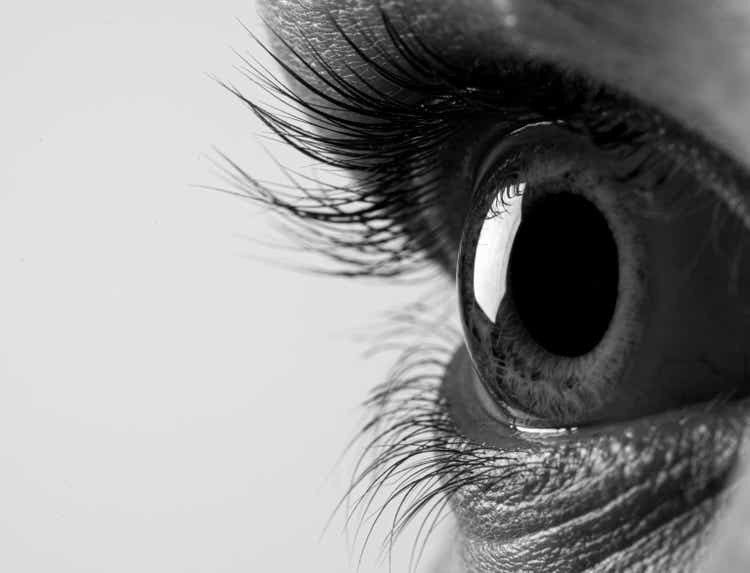Jonathan Knowles/DigitalVision via Getty Images
Oyster Point Pharma, Inc. (NASDAQ:OYST) has an approved product, Tyrvaya (OC-01, varenicline solution) Nasal Spray for treating dry eye disease, and it is also in the pipeline for Neurotrophic Keratopathy Stage 1. NK is a rare disease characterized by decreased corneal sensitivity and poor corneal healing. For the pipeline program, the company says in its earnings call:
We continue to enroll patients in our OLYMPIA Phase 2 study of OC-01 nasal spray aimed at treating Stage 1 NK. We remain on track to expect results of this trial in the second half of this year.
Now, coming to the approval, Tyrvaya was approved in October 2021 and started in the market by early November. So this was effectively the first full quarter of reported earnings for Tyrvaya.
Dry eye disease occurs in over 38 million Americans. Current treatment options are Allergan’s Restasis and Shire’s Xiidra; both are given as eye drops. Restasis is a mild immunosuppressant while Xiidra is an anti-inflammatory drug. However, given the formulation that requires giving the medications directly to the eye – always a cumbersome and painful process – compliance is low. Moreover, these therapies take months to work from the onset of treatment. The company says there are 7 million patients that have tried and abandoned the standard therapies.
Tyrvaya uses a completely new delivery method, as well as a unique mechanism of action. It is used as a nasal drop, and it works by triggering the trigeminal nerve which in its turn triggers tear production. In 3 clinical trials in over 1000 patients in mild, moderate and severe dry eye disease – ONSET-1, ONSET-2 and MYSTIC – the drug has demonstrated safety and efficacy. Patients showed statistically significant improvements in tear film production as assessed using the Schirmer’s score at Week 4, with more than 50% patients showing optimal tear production compared to about half that number in the placebo group:
TYRVAYA-treated patients showed statistically significant improvements in tear film production as assessed using the anesthetized Schirmer’s score (0-35 mm) at Week 4. Of the patients treated with TYRVAYA, 52% achieved ≥10 mm increase in Schirmer’s score from baseline in the ONSET-1 study, and 47% achieved ≥10 mm increase in Schirmer’s score from baseline in the ONSET-2 study, compared to 14% and 28% of vehicle-treated patients in the ONSET-1 study and the ONSET-2 study, respectively at Week 4 (p<0.01 in both studies). Of the patients treated with TYRVAYA, the mean change in Schirmer’s score was 11.7 mm and 11.3 mm as compared to 3.2 mm and 6.3 mm in the vehicle treated patients in the ONSET-1 study and ONSET-2 study, respectively at Week 4.
So the first full quarter revenue is $2.7mn. Around 19,000 prescriptions were filled, and these were written by 4500 unique prescribers. 65% of all patients went for refills. A number of patients have continued using the medicine for 6 months starting from November.
The company has also taken great strides on the mediclaim front. In February, TYRVAYA was placed on Express Scripts National Preferred basic and high performance formularies, which collectively make up around 26 million lives. The company has gone on to add more payers, and now it has commercial coverage for up to approximately 95 million lives, which represents 52% of all U.S. commercial lives.
Financials
OYST has a market cap of $134mn and a cash balance of $144mn. This is a terrible state of affairs. There’s a short interest of 22%, which says that the market still thinks the company is overvalued. For a commercial stage company with a clinically successful drug to be in this sorry state is unnerving for investors.
Sales and marketing expenses for the three months ended March 31, 2022, were $27.0 million, General and administrative expenses were $12.9 million, and Research and development expenses were $4.7 million. Net product revenues for the three months ended March 31, 2022, were $2.7 million. At this rate, and ignoring any major improvement in sales, the company hardly has cash for 2 more quarters.
In order to curtail some of these high expenses – high for a small company, that is – the company has gone through a restructuring process. This, it says, will lead to $6M-$8M in savings this year but also include laying off up to 50 workers. The company expects savings of $40-$48mn in 2023. These measures will allow it to commercialize Tyrvaya better, and also put focus on the NK pipeline program. This plan will also include retiring John Snisarenko, Chief Commercial Officer, effective July 1.
The company signed a deal with a Chinese firm last year to commercialize Tyrvaya in China against $17.5mn in upfront payment and a stake in that Chinese company.
Bottom Line
I really have nothing to say. Restasis is a billion dollar drug, while Xiidra is a half-a-billion dollar drug. Tyrvaya has an admittedly better mechanism of action and mode of delivery. Yet it is floundering in the market, and I cannot find any reason for that except perhaps lack of execution, which is also difficult to allege given what the company has been doing. All in all, this is a perplexing situation, and when I am perplexed, I tend to avoid buying.
About the TPT service
Thanks for reading. At the Total Pharma Tracker, we offer the following:-

Our Android app and website features a set of tools for DIY investors, including a work-in-progress software where you can enter any ticker and get extensive curated research material.
For investors requiring hands-on support, our in-house experts go through our tools and find the best investible stocks, complete with buy/sell strategies and alerts.
Sign up now for our free trial, request access to our tools, and find out, at no cost to you, what we can do for you.



Be the first to comment